When it comes to colours and design, most of us will usually just pick what “feels right” or “looks good” for our interior. Of course, we are entitled to just go by gut because it is, after all, our living space, so it’s important to be happy and comfortable in it. However, many people may not realize that the colours we choose can have different effects on our rooms, and on our mind. Some colours can give the illusion of a room having more or less space than it actually does, whereas some colours can make us feel more relaxed or maybe even hungry! Therefore it’s worth considering what effect the colour schemes of the rooms in your living space are having on you, because they may perhaps be making things more difficult! Read on to find what some of the more mainstream colours and shades in the design world can offer to your interior, as well as some tips on how to pick the right colours for you.
Reds, Oranges and Yellows
These colours are known have a stimulating effect because they are very high-energy. Therefore they’re better suited to more lively and energetic areas like the kitchen/dining room as well as the living room, or any other room that sees the most footfall in the form or family or friends. The colours themselves are lively so can have the effect of livening up those who are exposed to it due to their vibrancy.
Red
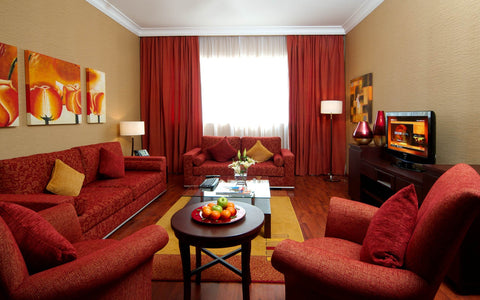
Red, in particular, is seen as the most powerful colour in terms of the effect it can have on people. Some of its startling effects include its ability to increase metabolism as well as respiration rate. In fact, red has also been known to raise blood pressure! It’s certainly one of, if not the, most bold and eye-catching colours to be found in nature. A harsher shade of red can sometimes be seen as a warning or a threat – and so could potentially keep you a little bit on edge – so it may be wise to opt for a warmer hue that is not quite so garish. Whilst red can be a very stimulating colour, you need to be very careful with when and where you use it – it can also increase appetite so perhaps use it frequently in kitchens, but more sparingly in bedrooms! Overall, the colour red is associated with love, romance, warmth and energy – and the shade you choose will determine whether the effect is immense or more subtle.
Orange
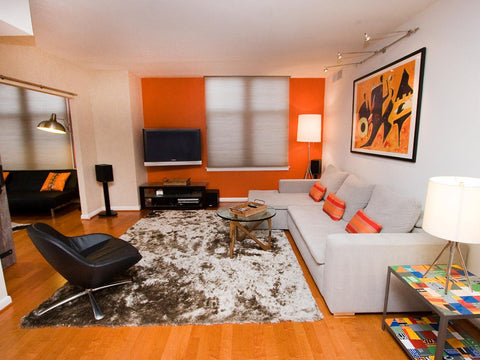
Orange is made from red and yellow, and therefore has some of the same properties discussed before – namely, that it is also stimulating for the mind as well as the stomach! It has connotations of food, warmth and fun. Orange is seen as light and tropical, that’s why it’s often used in tropical scenes or in artwork and decoration for youngsters because it can add a light and entertaining vibe to a room. A deeper orange is reminiscent of the autumn time, particularly the withered leaves that descend from the branches and pile up on the floor. On the whole, the colour orange radiates warmth, energy and fun.
Yellow
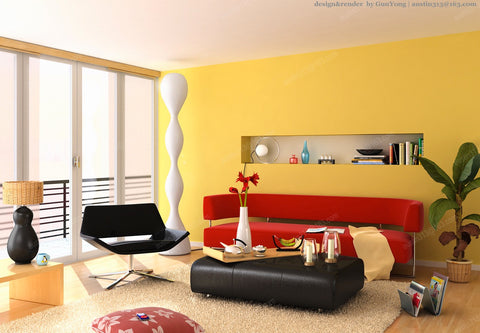
Yellow is also cheery and fun like its friends. It is most definitely a colour that will turn heads and attract attention, and therefore it’s no surprise that school buses and taxis are often this colour. Using yellow within your home can cultivate a fun and vibrant mood due to its sheer brightness – however, be careful not to go for something too vivid in too many places as it could prove to be a bit of an eyesore. A pale yellow should be enough if you want to bring a bit of vibrancy and sunshine into your living room. Yellow is great for attracting attention to certain aspects of your room – your décor or perhaps an accent wall or statement piece.
Pink
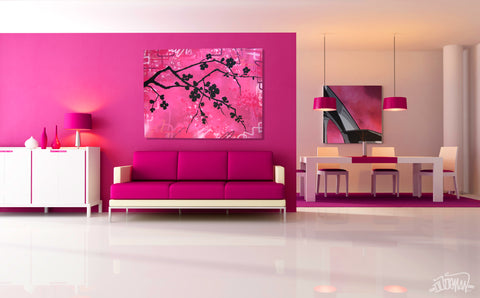
Pink is good if you want more a “fresh” feel to your room or living space. It is a light and airy colour that isn’t at risk of being too overbearing – unless you are heavy-handed with some of the bolder shades like hot pink. Pink has soothing and calming psychological effects and can bring something tasty to a room. The colour is largely associated with romance, love and gentleness.
Blues, Greens & Purples
This family of colours is relaxing and can bring about a peaceful and tranquil atmosphere. For this reason, they often feature within bedrooms and bathrooms, as these are traditionally places where we wind down, perhaps in our bed or in a bath.
Blue
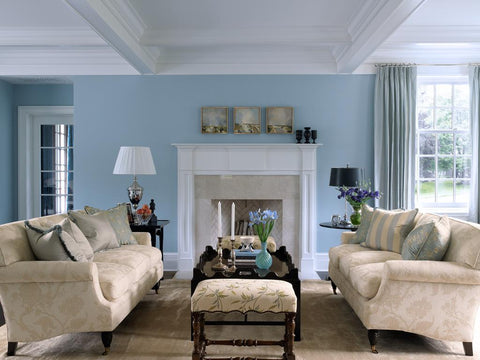
Blue is a very calming colour and can be used to “cool” a room – in the sense that it can give the illusion that a room is colder than it is – making it a great addition to a space that is prone to becoming very warm. Blue is also useful for study spaces or places of relaxation because it helps to soothe us and therefore makes it easier to clear our minds and focus upon whatever we wish to focus upon. It is also said to decrease appetite, especially if dishes or kitchen walls are painted blue. The colour blue exerts serenity and peace and has even been known to lower blood pressure, as opposed to red raising it.
Green
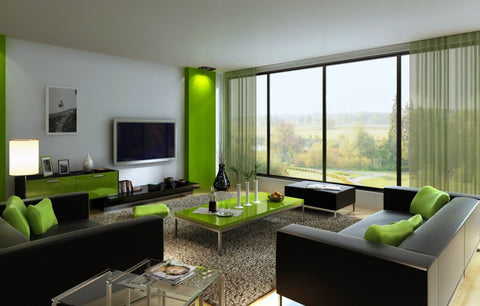
Green is also very calming and can create a serene atmosphere within your home. It is advised to use green, in the same manner, you would use blue within your homes, for they have very similar psychological effects. Green works well when paired with other colours within your interior, and is a colour that radiates harmony and serenity, and keeps us in touch with nature.
Purple
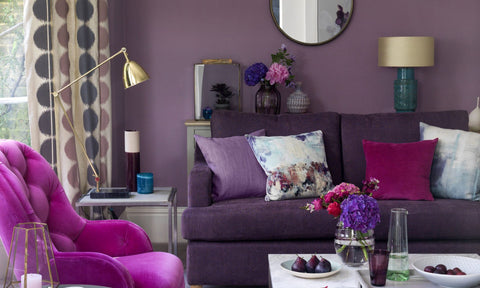
Purple reeks of royalty and sophistication so are perfect if you want that regal and powerful feel to your room. A bluish purple is more serene whereas a deeper or redder purple is more eye-catching, so pick according to the kind of mood you are going for.
White, Black, Grey & Brown
Neutral colours blend well with almost anything. They’re good for playing it safe, or if you’re not sure what colour scheme you want to go to with your home.
White

White is a neutral colour which gives off an air of cleanliness and spaciousness, and it can often be very refreshing. White can also give a sacred, “pure” feel to a room or something like a greenhouse or your personal sanctuary. When walls and furniture and even the floor are white it creates the illusion of more space within the room, as well as providing adding a bit of vigour and light to the room. White also works fantastically with its neutral counterparts, which is handy if you are hesitant to use it on its own or make it the dominant colour in your living space. It also packs a punch when used sparingly, for example, to highlight a certain window or piece of art hung on the wall.
Grey
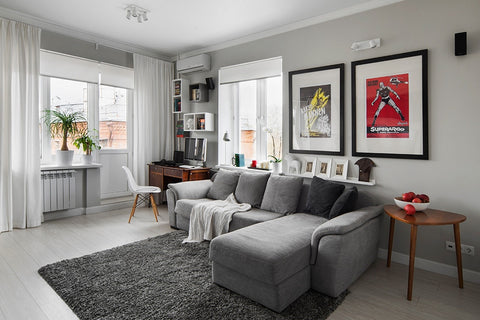
Grey is also neutral yet very elegant. Depending on how you use it, its subtlety can be pleasant, and a breath of fresh air in a room. However, grey is also susceptible to making a room look rather drab and old, so be sure not to overdo it or it may have an adverse effect on your interior.
Brown
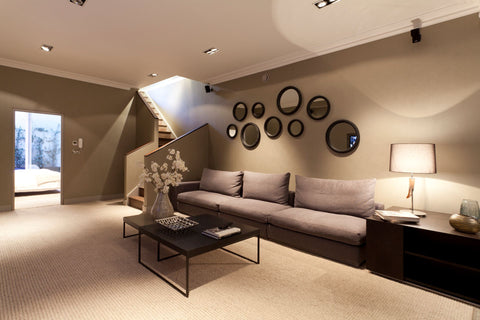
Brown is a recurring colour in nature – we see it in the earth, in trees and even in volcanoes. This is likely why brown is seen as an “earthy” colour, because of its connection to the natural world. Brown can help us to feel safe and grounded, and thereby make us more comfortable in our homes. Brown walls and furniture are great for adding an extra dimension, some extra depth, to any room, and make it more inviting and comfortable. The colour brown can create a rustic and homely effect within your living room, making it a soothing place to sit and relax with family. Brown gives off vibes of ease, friendliness and comfort.
Black
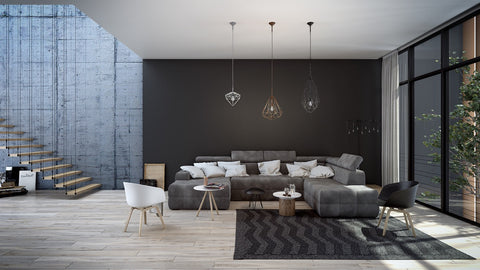
Black is known to be a very sophisticated and chic colour and can add this effect to any interior. If you get the balance right, it can transform a room from bleary to bold yet elegant. Black is an especially strong colour when paired with lighter tones, like a white wall or photo frame. Just as white is good for directing the eye to certain spots in a room, so is black. With black, it really can be “less is more”, especially because it is seen as a more sombre colour and a colour of mourning. Overdoing the use of black will likely not do much good for the aesthetic of the room.
Small Spaces and Big Bedrooms
Taking into account the size of a room is imperative when you are thinking about choosing colours. If your space is small, the colours on the warmer end of the spectrum could make a space feel even more cramped. Similarly, an already large space will feel larger should you opt for the cooler blues and greens. You may think making a large room feel even larger is an added bonus, but oftentimes if a space is too big it can be a struggle to make it feel comfortable and homely, as large areas of it can feel bare and neglected.
If you want to squeeze every last inch out of a smaller space, it would be worth ensuring the walls are a lighter hue, as lighter colours give the illusion of more space. Think cool pastels and neutral colours like white and beige if you want to “open up” a room. A room can also have the effect of seeming wider if the furniture matches the walls, or is at least of a similar hue because the colours amalgamate and give the impression that the room is light and airy.
Another tip is to try and make sure your ceiling is a light colour. It is advisable to make sure a room’s colour gradient (from bottom to top) goes darker to lighter, as a dark ceiling is unsightly in most settings. A light ceiling, on the other hand, can give the impression of the ceiling being higher than it actually is, so is ideal for lower ceilings that can sometimes feel a bit foreboding. As a general rule, try and make sure your ceiling has the lightest hue in the room. When it comes to a wall, a bright colour is good for diverting attention to a certain wall, perhaps an accent wall, but bright and bold colours can be overkill if used on all the walls – the balance can often be difficult to achieve, so think carefully before slathering the walls in hot pink!
Warm, Cool and Some Nifty Rules
Warm colours are more effective if you are trying to cultivate an atmosphere of togetherness and well…warmth! However, be mindful of the fact that even if you use a warm colour, a warm colour that is also bright can negate the effect you’re going for. Be sure to use more subdued hues if you don’t want to room to seem too busy and energetic.
Cool colours are fresher, as well as soothing. Deeper shades of cool colours can create an air of serenity, which is especially useful for bedrooms. Green, in particular, can help us feel safe and more in touch with nature because it can be found so frequently in the natural world. Green, however, is not very flattering to our skin, because green is poor at reflecting light. It may be worth keeping this in mind when considering which spaces of yours will feature green heavily and which ones won’t.
Apart from the warm and cool colours, you have the neutrals. These are good if this is your first foray into interior design, as they are safe colours that mesh well with most hues, making it harder to go wrong with them. Due to their versatility, they can adapt well to any changes in colour scheme or general theme.
Technical Tips
If you want to go with science rather than gut feeling, it would do you well to check out a colour wheel. It is a trusted method of colour matching and selection, used by many designers and artists. It can be found easily online, with a simple Google Images search for “colour wheel”, and this nifty circle will let you know which colours are a good contrast and couple. Colours that are next to each other on the wheel are known as “analogous colours”, whilst two colours directly opposite each other are called “complementary colours”. Using a few analogous colours can lead to a cohesive, pleasing colour scheme in your home, and complementary colours are also a good match because though they contrast they balance each other pleasantly. If you want to try and be a bit more daring try and incorporate a couple of complementary colours into a room to bring a pop of colour. You could use the pairing of blues and greens for the walls, for example, to create something very soothing and pleasant. A quick glance at the colour wheel shows us that blue is opposite orange, so some décor or a table that is of an orange hue will greatly complement your design.
Sticking with the technical theme, there is another handy piece of colour scheme advice commonly used in the interior design world, and it goes by the name of the “60-30-10 Rule”. This rule advises that 60 percent of a room’s colour should consist of a dominant colour, 30 percent a different colour, and the final 10 percent should be an accent colour. This tried and method has proven successful when it comes to balancing colours in a room without it all seeming like way too much, or not enough.
Sometimes we can go overboard with brighter, bolder hues, which can make as space seem very crowded and busy. Other times we go a bit too safe and stick only to neutral colours, which can leave a room feeling somewhat tired and underwhelming. The dominant hue should be a neutral, or softer colour so as to ensure that the room is not too overwhelming to the eye. The secondary colour is better off being a bolder hue, but keep in mind that this 30 percent mustn’t be too garish either. You can fulfil any desire for a bold and brilliant colour in the final 10 percent so that it complements the neutrals rather than overwhelms them. This 10 percent can consist of furniture, wall décor, or maybe just a solitary wall in your colour of choice. This accent colour is what will add the vibrancy and freshness to the room, and keep it exciting. You can find this 60-30-10 rule in many areas of design, from painting to fashion design.
So there you have it, these were some tips and tricks when it comes to picking the right colour scheme for your interior. Remember, you don’t have to commit to any colour straight away, start off the neutrals and take it from there, or use a small sample of paints to visualize a room that could potentially be a winner.
source https://www.otomo.co.uk/blogs/news/how-the-right-colours-can-transform-your-homes-interior
No comments:
Post a Comment